Difference between revisions of "Fungi Flashcards"
Jump to navigation
Jump to search
m (→Fungi) |
m |
||
| Line 9: | Line 9: | ||
==<font color="purple">Fungi</font>== | ==<font color="purple">Fungi</font>== | ||
| + | [[Image:Candida albicans.jpg|thumb|right|150px|''Candida albicans'' - wikimedia commons]] | ||
{| border="3" cellpadding="8" | {| border="3" cellpadding="8" | ||
!width="400"|'''Question''' | !width="400"|'''Question''' | ||
Revision as of 16:30, 16 May 2009
|
|
Fungi
| Question | Answer | Article |
|---|---|---|
| What is mycology? |
|
Link to Answer Article |
| What is the function of the cell membrane? |
|
Link to Answer Article |
| Which substances are stored in the cytoplasm in granules? |
|
Link to Answer Article |
| What are the main characteristics of filamentous fungi? |
|
Link to Answer Article |
| What are the main characteristics of dimorphic fungi? |
|
Link to Answer Article |
| How would you recognise yeast cells? |
|
Link to Answer Article |
| What are the three types of fungal spore produced? |
|
Link to Answer Article |
| Fill in the missing words about immunity to fungal infections | Cutaneous and superficial fungal infections are normally self-limiting with recovery associated with a resistance to re-infection. As hosts often develop delayed-type hypersensitivity this resistance appears to be cell-mediated. | Link to Answer Article |
